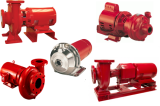Have you heard about the New DOE Water Pump Efficiency Guidelines?
Fresh water pumps have recently joined the list of products subject to energy efficiency standards. These changes will affect everyone from customers to estimators to inspectors. There are benefits to offering energy efficient equipment beyond complying with a regulation:
-
Stay competitive with new products
-
Motivate buyers with projected energy savings
Every Bell & Gossett e-Series pump meets or exceeds the DOE’s 2020 efficiency standards.
Bell & Gossett prepared for the changes by introducing compliant products years in advance. B&G was proud to say their products were ahead of their time, but the new regulations went into effect in Jaunary, 2020. B&G offers a whitepaper answering the most important questions. Read “FAQ: What engineers Need to Know.”
Which kinds of pumps does the rule include?

B&G End Suction Pumps
The new pump efficiency guidelines applies to several types of pumps:
- In-line
- End-suction close-coupled
- End-suction frame-mounted
- Vertical submersible turbines
- Radially split, multistage, vertical, in-line casing diffusers
What are the new pump efficiency guidelines?
The regulation went into effect on Jan. 27, 2020. The Energy Conservation Program for Certain Industrial Equipment states that new pumps sold in the US, along with their attached controls, must meet a specified rating on the new Pump Energy Index (PEI).
From the 2016-01-26 Energy Conservation Program: Energy Conservation Standards for Pumps; Final rule.
Under the adopted standards, a pump model would be compliant if its PEI rating is less than or equal to the adopted standard. PEI is defined as the pump efficiency rating (PER) for a given pump model (at full impeller diameter), divided by a calculated minimally compliant PER for the given pump model. PER is defined as a weighted average of the electric input power supplied to the pump over a specified load profile, represented in units of horsepower (hp). A value of PEI greater than 1.00 would indicate that the pump does not comply with DOE’s energy conservation standard, while a value less than 1.00 would indicate that the pump is more efficient than the standard requires.
| Equipment class * | Standard level **PEI | Efficiencypercentile | C-Values |
|---|---|---|---|
| ESCC.1800.CL | 1.00 | 25 | 128.47 |
| ESCC.3600.CL | 1.00 | 25 | 130.42 |
| ESCC.1800.VL | 1.00 | 25 | 128.47 |
| ESCC.3600.VL | 1.00 | 25 | 130.42 |
| ESFM.1800.CL | 1.00 | 25 | 128.85 |
| ESFM.3600.CL | 1.00 | 25 | 130.99 |
| ESFM.1800.VL | 1.00 | 25 | 128.85 |
| ESFM.3600.VL | 1.00 | 25 | 130.99 |
| IL.1800.CL | 1.00 | 25 | 129.30 |
| IL.3600.CL | 1.00 | 25 | 133.84 |
| IL.1800.VL | 1.00 | 25 | 129.30 |
| IL.3600.VL | 1.00 | 25 | 133.84 |
| RSV.1800.CL | 1.00 | † 0 | 129.63 |
| RSV.3600.CL | 1.00 | † 0 | 133.20 |
| RSV.1800.VL | 1.00 | † 0 | 129.63 |
| RSV.3600.VL | 1.00 | † 0 | 133.20 |
| VTS.1800.CL | 1.00 | †† 0 | 138.78 |
| VTS.3600.CL | 1.00 | 25 | 134.85 |
| VTS.1800.VL | 1.00 | †† 0 | 138.78 |
| VTS.3600.VL | 1.00 | 25 | 134.85 |
Why the changes?
 The US Department of Energy (DOE) determined higher energy conservation standards for pumps will save significant amounts of energy. According to DOE estimates, these standards will eventually save 0.29 quadrillion BTUs between 2020 and 2050. Reducing carbon-based pollution is linked in studies to improved community health, reduced environmental strain on infrastructure, as well as job growth. Strategists believe reducing US dependence on fossil fuels makes the nation less vulnerable politically, too. All of these outcomes yield economic and quality of life benefits.
The US Department of Energy (DOE) determined higher energy conservation standards for pumps will save significant amounts of energy. According to DOE estimates, these standards will eventually save 0.29 quadrillion BTUs between 2020 and 2050. Reducing carbon-based pollution is linked in studies to improved community health, reduced environmental strain on infrastructure, as well as job growth. Strategists believe reducing US dependence on fossil fuels makes the nation less vulnerable politically, too. All of these outcomes yield economic and quality of life benefits.
The Hydrolic Institute provided guidance and advocated for the industry. HI was integral in facilitating the data collection and standards development required for drafting the new pump efficiency guidelines. The DOE has dual goals of reducing environmental pollutants and to significantly reduce the nation’s dependence on fossil fuels. The changes were deemed technologically feasible and economically justified on a large scale. The market is responding to these regulations by developing more efficient products and bringing them to market. Bell & Gossett is chief among them, introducing a compliant line of pumps three years ahead of time. At Langley, our goals are to provide you with superior products and expert service.
Are you ready to meet demands of the future? Let they hydronic experts at FPL help you prepare for pump efficiency guidelines.

